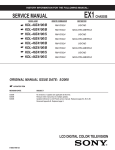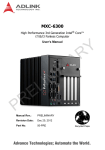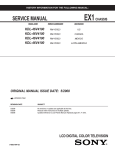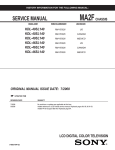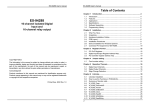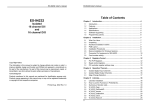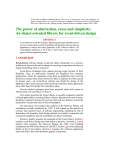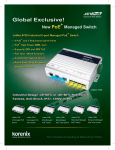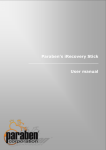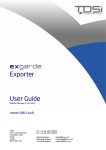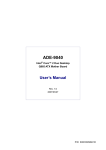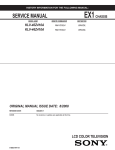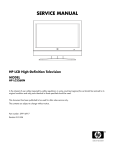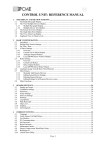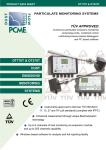Download EOS-1200 Manual
Transcript
EOS-1200 4-CH Gigabit PoE Embedded Vision System User’s Manual Manual Rev.: 2.00 Revision Date: Dec. 28, 2011 Part No: 50-1Z111-2000 Advance Technologies; Automate the World. Revision History ii Revision Release Date 2.00 Dec. 28, 2011 Description of Change(s) Initial release EOS-1200 Preface Copyright 2011 ADLINK Technology Inc. This document contains proprietary information protected by copyright. All rights are reserved. No part of this manual may be reproduced by any mechanical, electronic, or other means in any form without prior written permission of the manufacturer. Disclaimer The information in this document is subject to change without prior notice in order to improve reliability, design, and function and does not represent a commitment on the part of the manufacturer. In no event will the manufacturer be liable for direct, indirect, special, incidental, or consequential damages arising out of the use or inability to use the product or documentation, even if advised of the possibility of such damages. Environmental Responsibility ADLINK is committed to fulfill its social responsibility to global environmental preservation through compliance with the European Union's Restriction of Hazardous Substances (RoHS) directive and Waste Electrical and Electronic Equipment (WEEE) directive. Environmental protection is a top priority for ADLINK. We have enforced measures to ensure that our products, manufacturing processes, components, and raw materials have as little impact on the environment as possible. When products are at their end of life, our customers are encouraged to dispose of them in accordance with the product disposal and/or recovery programs prescribed by their nation or company. Trademarks Product names mentioned herein are used for identification purposes only and may be trademarks and/or registered trademarks of their respective companies. Preface iii Conventions Take note of the following conventions used throughout this manual to make sure that users perform certain tasks and instructions properly. Additional information, aids, and tips that help users perform tasks. NOTE: CAUTION: WARNING: iv Information to prevent minor physical injury, component damage, data loss, and/or program corruption when trying to complete a task. Information to prevent serious physical injury, component damage, data loss, and/or program corruption when trying to complete a specific task. Preface EOS-1200 Table of Contents Revision History...................................................................... ii Preface .................................................................................... iii List of Figures ........................................................................ ix List of Tables.......................................................................... xi 1 Introduction ........................................................................ 1 1.1 Overview.............................................................................. 1 1.2 Features............................................................................... 1 1.3 Specifications....................................................................... 2 1.4 Unpacking Checklist ............................................................ 4 2 System Description............................................................ 5 2.1 2.2 2.3 Schematics .......................................................................... 5 Front Panel I/O Connectors ................................................. 7 2.2.1 LED Indicators ............................................................ 8 2.2.2 Power Switch.............................................................. 8 2.2.3 Reset Button............................................................... 8 2.2.4 PS/2 Connector .......................................................... 8 2.2.5 Dual Gigabit Ethernet Ports........................................ 9 2.2.6 DVI-I connector......................................................... 10 2.2.7 USB 2.0 Connectors................................................. 11 2.2.8 USB 3.0 Connectors................................................. 11 2.2.9 CFast Slot................................................................. 12 2.2.10 PoE (Power over Ethernet) Ports ............................. 12 Rear Panel I/O Connectors................................................ 14 2.3.1 DC Power Supply Connector.................................... 15 2.3.2 Audio Jacks .............................................................. 15 2.3.3 DB-62P COM Port Connector .................................. 15 Table of Contents v 2.3.4 2.4 2.5 Rear Panel Digital I/O ............................................... 17 Internal I/O connectors....................................................... 19 2.4.1 Clear CMOS and ME RTC register Jumpers............ 20 2.4.2 DC 12V Fan Connector ............................................ 20 2.4.3 DC 12V Fan Connector (reserved) ........................... 20 2.4.4 USB 2.0 Type A Connector ...................................... 20 2.4.5 SUMIT Connector ..................................................... 21 2.4.6 SATA Connectors ..................................................... 22 General Purpose Digital Signals ........................................ 23 2.5.1 General Purpose Digital Output (EDO)..................... 23 2.5.2 General Purpose Digital Input (EDI) ......................... 24 3 Hardware Installation........................................................ 27 3.1 Installing memory............................................................... 27 3.2 Installing a Hard Disk Drive (HDD) .................................... 28 3.3 Installing the USB Dongle .................................................. 29 3.4 Installing Wall-Mount Brackets........................................... 30 4 OS & Driver Installation.................................................... 31 4.1 4.2 Operating System Installation ............................................ 31 4.1.1 Windows XP ............................................................. 31 4.1.2 Windows 7 ................................................................ 33 Driver Installation ............................................................... 35 4.2.1 Chipset Driver Installation......................................... 35 4.2.2 Graphics Driver Installation....................................... 36 4.2.3 Ethernet Driver Installation ....................................... 36 4.2.4 Audio Driver Installation............................................ 36 4.2.5 USB 3.0 Driver Installation........................................ 36 4.2.6 ME (Management Engine Components) Software Installation ................................................. 37 4.2.7 Digital Input/ Output Driver Installation ..................... 37 5 Function Library................................................................ 39 vi Table of Contents EOS-1200 5.1 List of Functions................................................................. 39 5.2 Data Types. ....................................................................... 40 5.3 Setting Up the Build Environment...................................... 40 5.4 5.5 5.6 5.7 5.3.1 Include Files ............................................................. 40 5.3.2 Library Files .............................................................. 41 5.3.3 DLL Files .................................................................. 41 System & Initialization Functions ....................................... 42 5.4.1 Register_Card .......................................................... 42 5.4.2 Release_Card........................................................... 43 5.4.3 GetBaseAddr ............................................................ 44 5.4.4 GetCardIndexFromID ............................................... 45 5.4.5 GetCardType ............................................................ 46 5.4.6 GetLCRAddr ............................................................. 47 DI/O Functions................................................................... 48 5.5.1 DI_ReadLine............................................................. 48 5.5.2 DI_ReadPort............................................................. 50 5.5.3 DO_ReadLine........................................................... 51 5.5.4 DO_WriteLine ........................................................... 52 5.5.5 DO_ReadPort ........................................................... 53 5.5.6 DO_WritePort ........................................................... 55 COS Interrupt Functions .................................................... 56 5.6.1 DIO_INT_Event_Message........................................ 56 5.6.2 DIO_INT1_EventMessage........................................ 58 5.6.3 DIO_INT2_EventMessage........................................ 59 5.6.4 DIO_SetDualInterrupt ............................................... 61 5.6.5 DIO_SetCOSInterrupt32........................................... 62 5.6.6 DIO_GetCOSLatchData32 ....................................... 64 Smart PoE Functions......................................................... 65 5.7.1 5.8 SmartPoE_SetPower................................................ 65 EEPROM Functions........................................................... 66 5.8.1 EEPROM_ReadByte ................................................ 66 5.8.2 EEPROM_WriteByte ................................................ 67 Table of Contents vii 5.8.3 EEPROM_WriteBytes............................................... 69 6 BIOS Setup ........................................................................ 71 6.1 Main ................................................................................... 72 6.1.1 6.2 6.3 Advanced ........................................................................... 73 6.2.1 ACPI Settings ........................................................... 74 6.2.2 CPU Configuration.................................................... 75 6.2.3 Onboard Device Configuration ................................. 77 6.2.4 Advanced Power Management................................. 78 6.2.5 SATA Configuration .................................................. 79 6.2.6 Intel Anti-Theft Technology Configuration ................ 80 6.2.7 AMT Configuration.................................................... 81 6.2.8 USB Configuration .................................................... 82 6.2.9 Super I/O Configuration ............................................ 83 6.2.10 Hardware Monitor ..................................................... 84 6.2.11 Serial Port Console Redirection................................ 85 6.2.12 Serial Port for Out-of-Band Management/EMS ........ 85 Chipset............................................................................... 86 6.3.1 6.4 System Time/System Date ....................................... 72 System Agent (SA) Configuration............................. 87 Boot ................................................................................... 89 6.4.1 Boot Configuration .................................................... 89 6.4.2 Boot Option Priorities................................................ 90 6.5 Security .............................................................................. 90 6.6 Exit ..................................................................................... 91 Important Safety Instructions............................................... 93 Getting Service ...................................................................... 95 viii Table of Contents EOS-1200 List of Figures Figure 2-1: EOS-1200 Front View...................................................... 5 Figure 2-2: EOS-1200 Rear View ...................................................... 5 Figure 2-3: EOS-1200 Top View ........................................................ 6 Figure 2-4: EOS-1200 Right Side View.............................................. 6 Figure 2-5: EOS-1200 Left Side View ................................................ 6 Figure 2-6: Front Panel I/O Connectors ............................................. 7 Figure 2-7: Gigabit Ethernet Ports ................................................... 10 Figure 2-8: DVI-I connector.............................................................. 10 Figure 2-9: PoE Port Connections ................................................... 12 Figure 2-10: Rear Panel I/O Connectors............................................ 14 Figure 2-11: DC Power Connector..................................................... 15 Figure 2-12: EOS-1200 Mainboard Top View .................................... 19 Figure 2-13: EOS-1200 Mainboard Underside View.......................... 22 List of Figures ix This page intentionally left blank. x List of Figures EOS-1200 List of Tables Table Table Table Table Table Table Table Table Table Table Table Table Table Table Table 1-1: 2-1: 2-2: 2-3: 2-4: 2-5: 2-6: 2-7: 2-8: 2-9: 2-10: 2-11: 2-12: 2-13: 6-1: List of Tables EOS-1200 General Specifications ................................... 2 Front Panel I/O Connector Legend.................................. 7 LED Indicators ................................................................. 8 Gigabit Ethernet Port Features ........................................ 9 Active/Link LED ............................................................. 10 Speed LED .................................................................... 10 DVI-I Connector Signals ................................................ 11 PoE Port Connections Legend ...................................... 13 Rear Panel I/O Connector Legend ................................ 14 DB-62P Connector Pin Assignment............................... 16 Rear Panel Digital I/O Pin Definitions ............................ 18 Rear Panel Digital I/O Pin Legend................................. 18 Mainboard Connector Legend ....................................... 19 SUMIT Pin Definitions.................................................... 21 Restore On Power Loss Options ................................... 78 xi This page intentionally left blank. xii List of Tables EOS-1200 1 Introduction 1.1 Overview ADLINK’s EOS-1200 is a rugged embedded vision system that features four independent Gigabit PoE (power over Ethernet) ports in a compact 220mm (W) x 80 mm (H) x 200 mm (D) small form factor chassis, with 2nd Generation Intel® Core™ i5/i7 processors providing ample power to manage demanding multicamera high resolution machine vision applications, such as robot guidance and 3D machine vision. The EOS-1200 supports rich I/O, including 4 RS-232/422/485, 4 USB 2.0, 2 USB 3.0, and 32 isolation digital I/O input, and dual storage support (two SATA and one CFAST slots). An internal USB port and 1 kbit Programmable EEPROM make the system friendly to integrate, deploy, and manage copy protection or software license authentication. With long-life embedded components and incorporated system monitoring components to monitor CPU temperature, fan speed, and system responsiveness, the EOS-1200 provides a notably robust and reliable platform for mission critical applications. 1.2 Features X 230W X 206D X 82H mm (9.06 X 8.11 X 3.23 in), compact and rugged system design X 2nd Generation Intel® Core™ i5/i7 processor X Up to 4 gigabit PoE (power over Ethernet) multi-camera support X Internal USB port and 1 Kbit Programmable EEPROM X IEEE-1588 (Precise Time Protocol) compliant for multi-camera synchronization X Supports two SATA ports and one CFast slot Introduction 1 1.3 Specifications General Specifications System Core Processor 2nd Generation Intel® Core ™ i5 2.5GHz or i7 2.1GHz Chipset Intel® QM6 Express Video VGA+DVI-D output by DVI-I connector- analog CRT, supports QXGA, 2048 x 1536 resolution Memory 2 socket slot for DDR3 1066/1333/1600 MHz SODIMM module (Max. capacity 8GB) Camera Interface 4-CH Gigabit PoE (power over Ethernet) IEEE 802.3af compliant, total max. power output 32W GigE Vision I/O Interface DI/O 16 DI/O in rear panel, DSUB37 female Ethernet 2x GbE port (1x Intel® 82574L, 1x Intel® 82579LM(PHY)) with WOL function on each port Serial Port 2x software-programmable RS-232/422/485 (COM1 & COM2) 2x RS-232 (COM3 & COM4) USB 4x USB 2.0 ports 2x USB 3.0 ports Audio 1x Mic-in and 1x Speaker-out KB/MS 1x PS/2 for keyboard and mouse (requires S3 wakeup) Power Supply DC Input Built-in 9-32 VDC wide-range DC 3P pluggable connector with latch (GND, V-, V+) AC Input Optional 150 W external AC-DC adapter Table 1-1: EOS-1200 General Specifications 2 Introduction EOS-1200 General Specifications Security USB 1x internal USB port supporting installation of a USB dongle for security function. ID 1kBit EEPROM Storage SATA HDD 2x SATA port for 2.5" HDD/SSD installation RAID 0/1/5/10 CFast 1x CFast slot, SATA 3Gb/s compatible Mechanical Dimensions 230W X 206D X 82H mm (9.06 X 8.11 X 3.23 in) Weight 3 kg (6.61 lb) Mounting Wall- and rail-mount kit OS Operating system Windows XP/XP Embedded Windows 7/7 Embedded Environmental Operating temperature 0° to 55° C (32 to 131° F) Storage temperature -40° to 85° C (-40 to 185° F) (excl. HDD/SDD/CFast) Humidity Approx. 95% @ 40° C (non-condensing) Vibration (Operating) CFast 5 Grms, 5-500 Hz, 3 axes SSD 3 Grms, 5-500 Hz, 3 axes HDD 0.5 Grms, 5-500 Hz, 3 axes Shock Operating, 30 Grms, half sine 11ms duration (CF or SSD) EMI CE, FCC Class A Table 1-1: EOS-1200 General Specifications Introduction 3 X Always disconnect the power cord from the chassis when working on the device, and do not reconnect while the power switch is on, since sudden power input can damage sensitive electronic components X Only authorized and experienced electronics personnel should open the chassis X Always ground yourself to remove any static electric charge before touching EOS, the device is very sensitive to static electric charges; use a grounding wrist strap at all times, and place all electronic components on a static-dissipative surface or in a static-shielded bag 1.4 Unpacking Checklist Before unpacking, check the shipping carton for any damage. If the shipping carton and/or contents are damaged, inform your dealer immediately. Retain the shipping carton and packing materials for inspection. Obtain authorization from your dealer before returning any product to ADLINK. Ensure that the following items are included in the package. X EOS-1200 unit X Wall mounting brackets (x2) X Mounting M4, 8mm screws (x4) X PS/2 Y cable X Gigabit PoE covers (x4) X USB dongle mounting bracket X User’s manual X ADLINK All-in-One DVD OEM versions with non-standard configuration, functionality, or packaging may vary according to individual requirements. NOTE: 4 Introduction EOS-1200 2 System Description This chapter describes appearance and connection of the EOS-1200, including chassis dimensions and front panel and internal I/O connectors 2.1 Schematics All units are in millimeters (mm) NOTE: 82 230 Figure 2-1: EOS-1200 Front View Figure 2-2: EOS-1200 Rear View System Description 5 Figure 2-3: EOS-1200 Top View Figure 2-4: EOS-1200 Right Side View Figure 2-5: EOS-1200 Left Side View 6 System Description EOS-1200 2.2 Front Panel I/O Connectors The EOS-1200 provides I/O connection on the front panel, as follows. J A B H G I F E D C Figure 2-6: Front Panel I/O Connectors A LED indicators B Power switch C Reset switch D PS/2 keyboard & mouse E Dual Gigabit Ethernet ports F DVI-I connector G USB 2.0 connectors x4 (Type A) H USB3.0 connector (Type A) x2 I CFast connector(Push-Push,Type II) J 4-CH PoE Connectors Table 2-1: Front Panel I/O Connector Legend System Description 7 2.2.1 LED Indicators In addition to the LED of the power switch, two LEDs on the front panel indicate the following. LED indicator Color Description X If lit continuously, indicates no physical storage is connected Diagnostic Yellow HDD Green X If blinking, indicates no memory is installed on either SO-DIMM socket When blinking, indicates the SATA hard drive is active Table 2-2: LED Indicators 2.2.2 Power Switch The power switch is non-latched, with a blue LED indicator. System is turned on when the button is depressed, and the power LED lights. If the system hangs, depressing the switch for 5 seconds turns the system off completely. 2.2.3 Reset Button The reset button executes a hard reset. 2.2.4 PS/2 Connector The EOS-1200 provides connectors for PS/2 keyboard and mouse, either singly or with a Y-cable to connect both at the same time. 8 System Description EOS-1200 2.2.5 Dual Gigabit Ethernet Ports The EOS-1200 provides two Gigabit Ethernet ports on the front panel, an Intel® 82574IT Gigabit Ethernet Controller and Intel® 82579LM Gigabit Ethernet PHY, with features as follows. Intel® 82574IT Gigabit Ethernet Controller Intel® 82579LM Gigabit Ethernet PHY Advanced error reporting 802.3x flow control-compliant Message signaled interrupts IEEE 802.1p and 802.1q support TCP segmentation offload/ large-send support Energy efficient Ethernet(EEE)802.3az support 802.3x flow control-compliant 10/100/1000 IEEE 802.3-compliant IEEE 802.1p and 802.1q support Automatic MDI/MDIX crossover at all speeds 10/100/1000 IEEE 802.3-compliant Wake-On-LAN feature Automatic MDI/MDIX crossover at all Support Intel® AMT 7.0 speeds ACPI 2.0 specification Reduced power consumption during normal operation and power down modes Wake-On-LAN Preboot eXecution Environment (PXE) flash interface support Fully integrated ASF 2.0 functionality 9 KB jumbo frame support with on-chip μc SMBus 2.0 master interface for ASF Supports LAN Teaming function functionality Preboot eXecution environment (PXE) flash interface support 802.3x flow control-compliant 9 KB jumbo frame support IEEE 802.1p and 802.1q support LAN Teaming Function support Energy Efficient Ethernet(EEE)802.3az support Table 2-3: Gigabit Ethernet Port Features Both Gigabit Ethernet ports provide function indication through LED display, as follows, with a yellow Activity indicator LED on the right side of the port, and a green/orange Speed indicator LED on the left. LED function is the same for both ports System Description 9 Figure 2-7: Gigabit Ethernet Ports LED Color Yellow Status Description OFF Ethernet port is disconnected. ON Ethernet port is connected with no activity. Flashing Ethernet port is connected and active. Table 2-4: Active/Link LED LED Color Green/ Orange Status Description OFF 10 Mbps Green 100 Mbps Orange 1000 Mbps Table 2-5: Speed LED 2.2.6 DVI-I connector The EOS-1200 provides one DVI-I connector for connection to an external monitor. The DVI-I connector can be separated into VGA and DVI-D (single link) interfaces. Figure 2-8: DVI-I connector 10 System Description EOS-1200 PIN Signal PIN Signal PIN Signal PIN Signal 1 DVIdata 2- 9 DVIdata 1- 17 DVIdata 0- C1 Analog Red 2 DVIdata 2+ 10 DVIdata 1+ 18 DVIdata 0+ C2 Analog Green 3 GND 11 GND 19 GND C3 Analog Blue 4 CRT DDC clock 12 N/C 20 N/C C4 Analog horiz. sync 5 CRT DDC data 13 N/C 21 N/C C5 Analog GND 6 DVIDC clock 14 +5V 22 GND 7 DVIDC data 15 GND 23 DVI clock + 8 Analog vert. sync 16 Hot plug detect 24 DVI clock - Table 2-6: DVI-I Connector Signals 2.2.7 USB 2.0 Connectors The EOS-1200 provides four Type A USB 2.0 ports on the front panel. All are compatible with Hi-Speed, full-speed, and low-speed USB devices. The EOS-1200 supports multiple boot devices, including USB flash, USB external HD, USB floppy, and USB CD-ROM drives. Boot priority and device can be configured in BIOS. Please refer to Section 6.2.8 USB Configuration for details. 2.2.8 USB 3.0 Connectors The EOS-1200 provides two Type A USB 3.0 ports on the front panel. Based on the TI TUSB7320RKM USB host controller, connection to the host system is achieved through a PCIe x1 Gen2 System Description 11 interface, supporting SuperSpeed, Hi-Speed, full-speed, and low-speed transmission for the downstream USB 3.0 ports. The EOS-1200 supports multiple boot devices, including USB flash, USB external HD, and USB CD-ROM drives. Boot priority and device can be configured in BIOS. While the USB 3.0 ports allow boot from CD-ROM, OS installation via CD-ROM is not supported. NOTE: 2.2.9 CFast Slot The EOS-1200 is equipped with a type II push-push CFast host connector on the front panel, connecting to the host controller by SATA interface. Data transfer rates up to 3.0Gb/s(300MB/s)/ 1.5Gb/s(150MB/s) are supported. The host SATA controller provides a legacy operating mode using I/O space, and an AHCI operating mode using memory space. The CFast card can function as a storage device for system installation. 2.2.10 PoE (Power over Ethernet) Ports LED2 8 LED1 1 Figure 2-9: PoE Port Connections 12 System Description EOS-1200 Pin Signal 1 MDI0+ 2 MDI0- 3 MDI1+ 4 MDI2+ 5 MDI2- 6 MDI1- 7 MDI3+ 8 MDI3- Table 2-7: PoE Port Connections Legend Power over Ethernet support includes: • Four fully-integrated Gigabit Ethernet Media Access Control (MAC) and physical layer (PHY) ports • Compliance with IEEE 802.3.af standard for a maximum of 8 W/ channel with power up to 48 V over the existing CAT-5 W with power up to 48 V over the existing CAT-5 Ethernet infrastructure with no need for modification • Standard IEEE 802.3 Ethernet interface for 1000BASE-T, 100BASE-TX, and 10BASE-T applications (802.3, 802.3u, and 802.3ab) • Smart PoE function provides manual power down of PoE supply with software API • 9 kB jumbo frame support Four LEDs, numbered 0-4, are deployed on the front panel to indicate the status of each PoE port, lighting when the respective port is active. System Description 13 2.3 Rear Panel I/O Connectors The EOS-1200 further provides I/O connection on the rear panel, as follows. N K M L Figure 2-10: Rear Panel I/O Connectors K DC Power Supply Connector L Audio Jacks M DB-62P COM Port Connector N Digital I/O Connector Table 2-8: Rear Panel I/O Connector Legend 14 System Description EOS-1200 2.3.1 DC Power Supply Connector Figure 2-11: DC Power Connector The DC power supply connector of the EOS-1200, on the back panel, consists of V-, chassis ground, and V+ pins, from right to left. V+ and V- pins accept DC power input and the chassis ground pin grounds the chassis for better EMC compatibility. The DC power input of the EOS-1200 allows a voltage input range from 9 VDC to 32 VDC. 2.3.2 Audio Jacks The EOS-1200 implements Intel High Definition audio on a Realtek ALC269 chip. The HD audio supports up to 24-bit, 192 KHz sample rate high quality headphone/speaker output and microphone input, accessed on the back panel, pink for microphone input, and green for speaker output. 2.3.3 DB-62P COM Port Connector The EOS-1200 provides four COM ports with DB-62P Connector on the back panel, with cable connect to DB-62P connector to extend four D-SUB 9-pin connectors, at COM1, COM2, COM3,and COM4. COM1 & COM2 can support RS-232/ RS-422/ System Description 15 RS-485 modes based on BIOS settings, and COM3 and COM4 ports support only RS-232. Pin assignments are as follows. PIN Signal Name 1 COM3_TXD 22 COM3_RXD 43 COM3_CTS# 2 COM3_DTR# 23 COM3_DSR# 44 COM3_RTS# 3 COM3_RI# 24 COM3_DCD# 45 GND 4 COM4_TXD 25 COM4_RXD 46 COM4_CTS# 5 COM4_DTR# 26 COM4_DSR# 47 COM4_RTS# 6 COM4_RI# 27 COM4_DCD# 48 GND 7 COM1_TXD 28 COM1_RXD 49 COM1_CTS# 8 COM1_DTR# 29 COM1_DSR# 50 COM1_RTS# 9 COM1_RI# 30 COM1_DCD# 51 GND 10 COM2_TXD 31 COM2_RXD 52 COM2_CTS# 11 COM2_DTR# 32 COM2_DSR# 53 COM2_RTS# 12 COM2_RI# 33 COM2_DCD# 54 GND 13-21 N/C PIN Signal Name 34-42 N/C PIN Signal Name 55-62 N/C Table 2-9: DB-62P Connector Pin Assignment 16 System Description EOS-1200 2.3.4 Rear Panel Digital I/O The EOS-1200 features a 16-CH isolated digital I/O on its back panel, based on an onboard digital I/O card supporting features as follows. 16-CH Isolated DI 16-CH Isolated DO Input Range : 0 – 24 V (please see Section Reducing DI channel Forward Current for High Voltage Output type: Darlington transistors Logic high: 5 – 24 V Sink current: Max 500 mA for each 8 channel set (DO 0~7 and DO 8~15) Logic low: 0 – 2 V Isolated voltage: 2500 Vrms Input resistance: 2.4 K Allowed input current : 50mA per channel (Max) Isolation voltage: 2500 Vrms Interrupt source: DI channel 0 to 15 Pin Definition Pin Definition 1 DI0 20 DI1 2 DI2 21 DI3 3 DI4 22 DI5 4 DI6 23 DI7 5 DI8 24 DI9 6 DI10 25 DI11 7 DI12 26 DI13 8 DI14 27 DI15 9 DI_COM1 28 DO_GND 10 DO_GND 29 DO_GND 11 DO0 30 DO1 12 DO2 31 DO3 13 DO4 32 DO5 14 DO6 33 DO7 15 DO8 34 DO9 16 DO10 35 DO11 System Description 17 Pin Definition Pin Definition 17 DO12 36 DO13 18 DO14 37 DO15 19 Clamp1 Table 2-10: Rear Panel Digital I/O Pin Definitions Din Isolated digital input channel #n Don Isolated digital output channel #n DI_COM1 Common Ground or Common power for front panel isolated input channels (DI0~DI15) DO_GND Ground return path for isolated output channels Clamp1 Power input signal of clamp diode for front panel DO channels (DO0~DO15) Table 2-11: Rear Panel Digital I/O Pin Legend 18 System Description EOS-1200 2.4 Internal I/O connectors C D F E B A Figure 2-12: EOS-1200 Mainboard Top View A Clear CMOS and ME RTC register jumpers B DC 12 V fan connector C DC 12 V fan connector (reserved) D COM port connector (optional) E USB 2.0 Type A connector F SUMIT Connector Table 2-12: Mainboard Connector Legend System Description 19 2.4.1 Clear CMOS and ME RTC register Jumpers When conditions occur under which the EOS-1200 controller fails to boot, clearing stored BIOS content from CMOS and restoring default settings may be required. To clear the CMOS, short pin#1 and pin#2 of JP1 and remove the jumper. CMOS restores to factory default settings Normal Clear As with JP1, shorting pin#1 and #2 of JP2 will clear the ME RTC register, however, since this jumper is used by RMA, this is not recommended, and may cause unexpected errors in system behavior. 2.4.2 DC 12V Fan Connector The EOS-1200 provides DC 12 V supply for fan module power. The FAN module, inside the chassis, uses power directly from this connector to exhaust heat, decreasing temperature of the system for more stable operation. 2.4.3 DC 12V Fan Connector (reserved) The EOS-1200 further reserves an additional DC 12 V supply connector for a second fan module. Like the first, the second module is inside the chassis, and uses power directly from this connector to exhaust heat, decreasing temperature of the system for more stable operation. 2.4.4 USB 2.0 Type A Connector A USB 2.0 Type A connector is provided to support expanded storage or security function through a dongle connection. The connector is deployed vertically, perpendicular to the board surface. 20 System Description EOS-1200 2.4.5 SUMIT Connector SUMIT is a connection protocol that integrates common high-and low-speed serial and legacy expansion buses for dedicated use. A compact, stackable, multiboard I/O expansion solution, the SUMIT connector supports one x1 PCI Express lane, one x4 PCI Express lane, and additional power, ground and control signals. Pin definitions are as follows. Pin Description Pin Description 1 GND 27 PCIex4_TX2+ 2 GND 28 PCIex4_RX2+ 3 PCIex1_TX+ 29 PCIex4_TX2- 4 PCIex1_RX+ 30 PCIex4_RX2- 5 PCIex1_TX- 31 GND 6 PCIex1_RX- 32 GND 7 GND 33 PCIex4_TX3+ 8 NC 34 PCIex4_RX3+ 9 PCIex4_CLK+ 35 PCIex4_TX3- 10 PCIex1_CLK+ 36 PCIex4_RX3- 11 PCIex4_CLK- 37 GND 12 PCIex1_CLK- 38 GND 13 NC 39 PERST# 14 GND 40 WAKE# 15 PCIex4_TX0+ 41 +V12 16 PCIex4_RX0+ 42 +V12 17 PCIex4_TX0- 43 +V5 18 PCIex4_RX0- 44 +V12 19 GND 45 +V5 20 GND 46 +V3.3 21 PCIex4_TX1+ 47 +V5 22 PCIex4_RX1+ 48 +V3.3 23 PCIex4_TX1- 49 +V5 24 PCIex4_RX1- 50 +V3.3 25 GND 51 +V5 26 GND 52 +V5SB Table 2-13: SUMIT Pin Definitions System Description 21 S AT A Figure 2-13: EOS-1200 Mainboard Underside View 2.4.6 SATA Connectors The EOS-1200 provides two SATA connectors supporting data transfer up to 6.0 Gb/s(600 MB/s). The SATA host controller supports legacy mode using I/O space and AHCI mode using memory space. The SATA connectors are compatible with 2.5 inch hard disk (HDD) or solid state disk (SSD) drives, which must be installed to the SATA connector with a HDD bracket. 22 System Description EOS-1200 2.5 General Purpose Digital Signals 2.5.1 General Purpose Digital Output (EDO) In the common ground connection of isolated digital output, as shown, when a “1” (logic high) is written by FPGA to a DO channel, the sink current passes through the transistors and the DO channel goes low. When a “0” (logic low) is written by FPGA to a DO channel, no current passes through the transistors and the DO channel goes high. When the load is of an “inductance nature” such as a relay, coil or motor, the VDD pin must be connected to an external power source. The extra connection is utilized for the ‘fly-wheel diode’ to form a current-release closed loop, so that the transistors are protected from any high reverse voltage generated by the inductance load when the output is switched from high to low. User Pull High Vdd EOS-1200 Iso_+5V Clamp Do From FPGA User Device Load DO User DI PC3H4 ISO_GND System Description User Device GND 23 2.5.2 General Purpose Digital Input (EDI) The EOS-1200 provides 16 opto-isolated digital input channels on the front panel. Circuitry of the isolated input channel is as follows. Ri DIn If DICOM Photo Coupler As shown, signal connections for a supply and load connected to an isolated input, here in the EOS-1200, can determine when a load is powered. The load is connected to the power supply by a switch and can be any DC voltage between 0 and 24 VDC. When the switch is open, no current flows through the load and no voltage is applied to the load or to the EOS-1200 DI channels. The digital logic of the EOS-1200 then registers a logic high for the channel. When the switch is closed, current flows through the diode and the EOS-1200 registers logic low for the channel. 24 System Description EOS-1200 +3.3V EOS-1200 10 k Digital Logic 2.4 k DI Load Supply ISO_COM Computer Ground Isolated Ground Reducing DI channel Forward Current for High Voltage As input voltage increases above 5 V, the input current drawn by the EOS-1200 (forward current If) rises commensurately. At 24 V, for example, current per line is determined by the formula: (24V- 0.5V)/2.4Kohm = 9.79 mA System Description 25 To reduce the current and the power drawn, on a monitored circuit, for example, another resistor can be added in series with the 2.4 kΩ current-limiting resistor, as shown. +3.3 V EOS-1200 10 k Rs 2.4 k DI L o a d Supply ISO_COM If Computer Ground It is recommended a resistance value be chosen allowing at least 5 mA through the diode, assuming a maximum drop across the diode of 0.5 V. For example, for 24 V inputs a maximum resistance for Rs can be found by the formula: (24 V-0.5 V)/5 mA – 2.4 kΩ = 2.3 kΩ 26 System Description EOS-1200 3 Hardware Installation This chapter describes accessing/changing memory modules, hard disk drives, and the USB dongle in the system. Wallmounting is also described. 3.1 Installing memory 1. Remove the two screws securing the bottom cover and remove, as shown. 2. Insert the memory module into the DDR3 SO-DIMM socket at a 45° angle and press down until the module is properly seated. Hardware Installation 27 3.2 Installing a Hard Disk Drive (HDD) 1. Remove the two screws securing the bottom cover and remove, as shown. 2. Remove the two screws fixing the hard drive carriage. 3. Slide the hard drive carriage out. 4. Remove the four screws from the hard drive to be removed. 5. Secure the new hard drive to the hard drive carriage. 6. Slide the hard drive carriage in, until received securely in the SATA power and data connectors. 7. Secure the hard drive carriage. 8. Replace the bottom cover. 28 Hardware Installation EOS-1200 3.3 Installing the USB Dongle 1. Remove the top cover by loosening the thumbscrew by hand or a screwdriver. C B D A 2. Once the USB dongle mounting bracket base D is fixed to the board surface via standoffs A, unscrew the thumbscrew B and loosen the USB dongle retainer C. 3. Slide the USB dongle retainer C upward to accommodate the USB dongle. 4. Plug the USB dongle into the USB port. 5. Slide the USB dongle retainer C down to secure USB dongle D to USB dongle mounting bracket base A and fasten thumbscrew B. Hardware Installation 29 3.4 Installing Wall-Mount Brackets 1. Secure the wall-mount brackets in the four screwholes provided on the underside of the chassis, as shown 30 Hardware Installation EOS-1200 4 OS & Driver Installation 4.1 Operating System Installation The EOS-1200 is compatible with several operating systems for maximum flexibility. Installation instructions for each follow. For other OS support, please contact ADLINK for further information. 4.1.1 Windows XP Installing AHCI on Windows XP Windows XP can be installed on an AHCI-enabled system by BIOS settings. Press “Delete” to enter the BIOS, and go to “SATA Configuration→SATA mode” to select AHCI. Install the Intel(R) Mobile Express Chipset SATA AHCI Controller driver over USB after pressing F6. If the driver is already running in IDE (ATA) emulation mode, no installation is required. Windows XP Windows XP supports EOS-1200 chipset drivers, allowing simple installation. ADLINK also provides pre-installation services for Windows XP on the EOS-1200 (when the Windows XP license is pre-purchased from ADLINK). Windows XP Embedded As a result of its overwhelming popularity, human-machine interface, and plentiful development tools, Windows XP is well suited to comparatively simple application development. Embedded XP is simply a modularized Windows XP. System developers select only the needed Windows XP components and functions and then organize them to construct an XP Embedded OS. With this architectural modularization, system integrators can readily reduce storage space requirements of XP Embedded. OS & Driver Installation 31 The only factor determining storage space requirements is the number of function modules needed. Because XP Embedded is wholly compatible with Windows XP, developers can compile controller software in the Windows XP environment and transfer the code to Embedded XP for immediate use. No new tools are required to use XP Embedded, lowering software development costs. Another advantage is the cost of licensing Embedded XP being much less than that of Windows XP. ADLINK currently provides standard XP Embedded OS images for the EOS-1200 (XP Embedded license pre-purchase from ADLINK is required). The standard XP Embedded OS image provided by ADLINK is about 1.4 GB, and key features include: ZXP Embedded OS Kernel ZDrivers for EOS H/W and peripheral cards ZTCP/IP Networking ZTCP/IP with file sharing and client for Microsoft net- work ZInternet ZFile Explorer Manager ZLanguage Support The standard XP Embedded OS image meets most application needs. If you have any special functional requirements for XP Embedded, please contact ADLINK for more details. 32 OS & Driver Installation EOS-1200 4.1.2 Windows 7 Installing AHCI on Windows 7 The AHCI driver must be enabled in the registry before SATA mode of the boot drive can be changed, as follows: 1. Exit all Windows-based programs 2. In the Start menu, enter regedit in the Start Search box, and select ENTER 3. If the User Account Control dialog box appears, select Continue 4. Locate and select the registry subkey HKEY_LOCAL_MACHINESystemCurrentControlSetS ervicesMsahci 5. In the Name column of the right pane, right-click Start, and select Modify 6. In the Value data box, enter 0 and select OK 7. In the File menu, select Exit to close the Registry Editor 8. Restart the computer, open the BIOS and enable AHCI. At the next Windows login, the drivers for AHCI show as intalled. 9. Restart a final time to complete the installation Windows 7 Windows 7 supports EOS-1200 chipset drivers, allowing simple installation. ADLINK also provides pre-installation services for Windows 7 on the EOS-1200 (when the Windows XP license is pre-purchased from ADLINK). For more information, please visit the OS website Windows 7 Embedded Service Pack 1 Windows Embedded Standard 7 SP1 delivers the power, familiarity, and reliability of the Windows 7 operating system in a componentized form, allowing developers to create advanced OS & Driver Installation 33 commercial and consumer devices compatible with thousands of existing Windows applications and drivers. You can download the evaluation version from: http:// www.microsoft.com/download/en/details.aspx?id=11887 The download contains 3 DVD5 images (ISO's). Download the .exe and .rar files for each DVD image into its own folder and run the .exe file in that folder to reconstitute the .ISO file. Once the .ISO file is created you can then burn the ISO onto a blank DVD. The toolkit DVD is used to install the Image Configuration Editor (ICE) and associated distribution share(s) onto a PC. The 32-bit and 64-bit Standard 7 SP1 DVDs are bootable WinPE DVDs that contain the Image Builder Wizard (IBW) and the corresponding 32-bit or 64-bit distribution share. Typically these DVDs are used to boot into Windows PE on the target device and apply the runtime image created with ICE or to prototype image creation using the wizard and various templates available in IBW. Please read the Windows Embedded Standard 7 SP1 documentation for more information on using ICE and IBW to create and deploy runtime images. 34 OS & Driver Installation EOS-1200 4.2 Driver Installation After the OS is installed, all related drivers must be installed. This section describes drivers needed for Windows operating systems and installation procedures. For other OS support, please contact ADLINK directly. Once Windows is properly installed, the following installations are required (most standard I/O device drivers have been included in the Windows install): 1. Install the chipset driver 2. Install the graphics driver 3. Install the Ethernet driver 4. Install the audio driver 5. Install the USB3.0 driver 6. Install the ME (Management Engine Components) software 7. Install the Digital Input/ Output Driver 4.2.1 Chipset Driver Installation The chipset driver directs the operating system to configure the Intel® QM67 chipset, to ensure that the following features function properly: Z Core PCI and ISAPNP services Z PCIe support Z SATA storage support Z USB support Z Identification of Intel® Chipset components in the Device Manager To install the chipset driver: 1. Close any running applications 2. Execute Chipset.exe and follow onscreen instructions 3. Reboot the system OS & Driver Installation 35 4.2.2 Graphics Driver Installation The EOS-1200 is equipped with the Intel® HD graphics family. To install the graphics driver: 1. Close any running applications 2. Execute Setup.exe in the Graphics folder and follow the onscreen instructions 3. Reboot the system 4.2.3 Ethernet Driver Installation To install the driver for the Intel® 82574L/82579LM Gigabit network connection: 1. Close any running applications 2. Execute Network.exe and follow onscreen instructions 3. Reboot the system 4.2.4 Audio Driver Installation Please follow the following steps to install the Realtek audio driver: 1. Close any running applications 2. Execute Setup.exe in Audio folder and follow the onscreen instructions 3. Reboot the system 4.2.5 USB 3.0 Driver Installation Please follow the following steps to install the Texas Instruments USB 3.0 driver: 1. Close any running applications 2. Execute Texas Instruments xHCI Driver v1.12.7 ( WHQL - Multilanguage ).exe in the USB3 folder and follow the onscreen instructions to complete the setup 3. Reboot the system 36 OS & Driver Installation EOS-1200 4.2.6 ME (Management Engine Components) Software Installation The Intel® Management Engine software components requiring installation depend on the system's specific hardware and firmware features. The installer detects system capabilities and installs the relevant drivers and applications. To install the ME Software: 1. Close any running applications 2. Execute Setup.exe in the ME_SW folder and follow the onscreen instructions 4.2.7 Digital Input/ Output Driver Installation To install the driver for ADLINK DIO: 1. Close any running applications. 2. Execute PCMe-1432_x86/64_v0.0.0.7.exe and follow the onscreen instructions to complete the setup. 3. Reboot the system. Following successful installation, the PCMe-1432 should appear in the directory, as shown. OS & Driver Installation 37 This page intentionally left blank. 38 OS & Driver Installation EOS-1200 5 Function Library This chapter provides a detailed description of the EOS-1200 function library. These functions, excluding SmartPoE and EEPROM, are compatible with the PCIS-DASK library, and can be used to develop applications under C++, C#, VB.Net, and Delphi. 5.1 List of Functions Category Function Register_Card Release_Card System & Initialization GetBaseAddr GetCardIndexFromID GetCardType GetLCRAddr DI_ReadLine DI_ReadPort DI/O DO_ReadLine DO_WriteLine DO_ReadPort DO_WritePort DIO_INT_Event_Message DIO_INT1_EventMessage COS Interrupt DIO_INT2_EventMessage DIO_SetDualInterrupt DIO_SetCOSInterrupt32 DIO_GetCOSLatchData32 Smart PoE SmartPoE_SetPower EEPROM_ReadByte EEPROM EEPROM_WriteByte EEPROM_WriteBytes Function Library 39 5.2 Data Types. Type Description Range U8 8-bit ASCII character 0 to 255 I16 16-bit signed integer -32768 to 32767 U16 16-bit unsigned integer 0 to 65535 I32 32-bit signed integer -2147483648 to 2147483647 U32 32-bit unsigned integer 0 to 4294967295 F32 32-bit singleprecision floatingpoint -3.402823E38 to 3.402823E38 F64 64-bit doubleprecision floatingpoint -1.797683134862315E308 to 1.797683134862315E308 5.3 Setting Up the Build Environment 5.3.1 Include Files All applications using API are required to include the following files. Include File Description Dask.h Header file required for all C/C++ applications. Dask.vb Function definitions required for all VB.Net applications. Dask.cs Function definitions required for all C# applications. PCMe1432.h Header file required for all C/C++ applications. PCMe1432.vb Function definitions required for all VB.Net applications. PCMe1432.cs Function definitions required for all C# applications. 40 Function Library EOS-1200 5.3.2 Library Files All C/C++ applications using API require the following library files. 5.3.3 Library File Description PCI-Dask.lib Exports API function definitions; required for all Visual C/C++ 32 bit applications. PCI-DASK_bcb.lib Exports API function definitions; required for all 32 bit Borland C++ Builder applications. PCMe1432.lib Exports API function definitions; required for all Visual C/C++ 32 bit applications. PCI-Dask64.lib Exports API function definitions; required for all Visual C/C++ 64 bit applications. PCMe1432x64.lib Exports API function definitions; required for all Visual C/C++ 64 bit applications. DLL Files All applications using API require the following DLL files. All files are located in [Installed directory]\ADLINK\PCMe1432\Include, where ‘Installed directory’ is the destination directory specified in the setup program. DLL File Description PCI-Dask.dll Dynamic link library. Required for all applications. PCMe1432.dll Dynamic link library. Required for all applications. Function Library 41 5.4 System & Initialization Functions 5.4.1 Register_Card Description Initializes the hardware and software states of a NuDAQ PCI-bus data acquisition card, and returns a numeric card ID corresponding to the initialized card. Register_Card must be called before any other PCIS-DASK library functions can be called for a particular card. The function initializes the card and variables internal to the PCIS-DASK library. Because NuDAQ PCI-bus data acquisition cards meet plugand-play specifications, the base address (pass-through address) and IRQ level are assigned directly by the system BIOS. Syntax C/C++ I16 Register_Card (U16 CardType, U16 card_num) Visual Basic Register_Card (ByVal CardType As Integer, ByVal card_num As Integer) As Integer VB.Net Register_Card (ByVal CardType As Short, ByVal card_num As Short) As Short C# short Register_Card (ushort CardType, ushort card_num) Parameter(s) CardType Type of card to be initialized. ADLINK periodically upgrades PCIS-DASK to add support for new NuDAQ PCI-bus data acquisition cards and NuIPC CompactPCI cards. Refer to release notes of the card to dtermine whether PCIS-DASK 42 Function Library EOS-1200 supports that card. These are the constants defined in DASK.H that represent the NuDAQ PCI-bus data acquisition cards supported by PCIS-DASK: PCMe_1432 card_num Sequence number of the card with the same card type (as defined in argument CardType) or that belongs to the same card type series (except PCI- 7300A_Rev. A and PCI7300A Rev. B) in the PCI slot. card_num is always equal to 0 for PCMe-1432. Return Code Returns a numeric card ID for the initialized card. The card ID range is between 0 and 31. If any error occurs, a negative error code is returned, with possible error codes as follows: ErrorTooManyCardRegistered ErrorUnknownCardType ErrorOpenDriverFailed ErrorOpenEventFailed 5.4.2 Release_Card Description A maximum of 32 cards can be registered simultaneously. This function informs the PCIS-DASK library that the registered card is not currently in use and can be released. Releasing a card clears space for a new card to register. This function is also applied at the end of a program to release all registered cards. Syntax C/C++ I16 Release_Card (U16 CardNumber) Visual Basic Release_Card (ByVal CardNumber As Integer) As Integer Function Library 43 VB.Net Release_Card (ByVal CardNumber As Short) As Short C# short Release_Card (ushort CardNumber) Parameter(s) CardNumber ID of the card for release. Return Code(s) NoError 5.4.3 GetBaseAddr Description Acquires I/O base addresses of the device with a specified card index Syntax C/C++ I16 GetBaseAddr (U16 CardNumber, U32 *BaseAddr, U32 *BaseAddr2) Visual Basic GetBaseAddr (ByVal CardNumber As Integer, BaseAddr As Long, BaseAddr2 As Long) As Integer VB.Net Release_Card (ByVal CardNumber As Short) As Short C# short GetBaseAddr (ushort CardNumber, uint [] BaseAddr, uint [] BaseAddr2) 44 Function Library EOS-1200 Parameter(s) CardNumber ID of the card for release. BaseAddr Returns the I/O base address. BaseAddr2 Returns the second base address #2. This is only available in cards that support two I/O base addresses, such as PCI9113 and PCI-9114. For PCI-6202, PCI-9221, PCI-9222, and PCI-9223, this parameter returns the memory address of the specified card. Return Code(s) NoError ErrorInvalidCardNumber ErrorCardNotRegistered ErrorFuncNotSupport 5.4.4 GetCardIndexFromID Description Obtains the card type and the sequence number of the device with a specified card ID. This is the reverse function of Release_Card. Syntax C/C++ I16 GetCardIndexFromID (U16 *cardType, U16 *cardIndex) CardNumber, U16 Visual Basic GetCardIndexFromID (ByVal CardNumber As Integer, cardType As Integer, cardIndex As Integer) As Integer Function Library 45 VB.Net GetCardIndexFromID (ByVal CardNumber As Short, ByRef cardType As Short, ByRef cardIndex As Short) As Short C# short GetCardIndexFromID (ushort CardNumber, out ushort cardType, out ushort cardIndex) Parameter(s) CardNumber ID of the card for release. CardType Returns the card type. CardIndex Returns the sequence number of the card of the same type Return Code(s) NoError ErrorInvalidCardNumber ErrorCardNotRegistered ErrorFuncNotSupport 5.4.5 GetCardType Description Obtains the card type of the device with a specified card index. Syntax C/C++ I16 GetCardType (U16 CardNumber, U16 *cardType) Visual Basic 46 Function Library EOS-1200 GetCardType (ByVal CardNumber cardType As Integer) As Integer As Integer, VB.Net GetCardType (ByVal CardNumber As Short, ByRef cardType As Short) As Short C# short GetCardType (ushort CardNumber, out ushort cardType) Parameter(s) CardNumber ID of the card for release. CardType Returns the card type. Return Code(s) NoError ErrorInvalidCardNumber ErrorCardNotRegistered ErrorFuncNotSupport 5.4.6 GetLCRAddr Description Obtains the LCR base address of the device with a specified card index as defined by the onboard PCI controller. Syntax C/C++ I16 GetLCRAddr(U16 CardNumber, U32 *LcrAddr) Visual Basic GetLCRAddr (ByVal CardNumber LcrAddr As Long) As Integer As Integer, VB.Net Function Library 47 GetLCRAddr (ByVal CardNumber As Short, ByRef LcrAddr As Integer) As Short C# short GetLCRAddr(ushort LcrAddr) CardNumber, uint [] Parameter(s) CardNumber ID of the card for release. LcrAddr Returns the LCR base address. Return Code(s) NoError ErrorInvalidCardNumber ErrorCardNotRegistered ErrorFuncNotSupport 5.5 DI/O Functions 5.5.1 DI_ReadLine Description Reads the digital logic state of the digital line in the specified port. Syntax C/C++ I16 DI_ReadLine (U16 CardNumber, U16 Port, U16 Line, U16 *State) Visual Basic 48 Function Library EOS-1200 DI_ReadLine (ByVal CardNumber As Integer, ByVal Port As Integer, ByVal Line As Integer, State As Integer) As Integer VB.Net DI_ReadLine (ByVal CardNumber As Short, ByVal Port As Short, ByVal Line As Short, ByRef State As Short) As Short C# short DI_ReadLine (ushort CardNumber, ushort Port, ushort Line, out ushort State) Parameter(s) CardNumber ID of the card for release. Port Digital input port number. Valid values: PCMe-1432 0, 1 Line Digital line to be read. Valid values:PCMe-1432 0 to 15 (for port 0 and port 1) State Returns the digital logic state of the specified line to 0 or 1 Return Code(s) NoError ErrorInvalidCardNumber ErrorCardNotRegistered ErrorFuncNotSupport ErrorInvalidIoChannel Function Library 49 5.5.2 DI_ReadPort Description Reads the digital data from the specified digital input port. Syntax C/C++ I16 DI_ReadPort (U16 CardNumber, U16 Port, U32 *Value) Visual Basic DI_ReadPort (ByVal CardNumber As Integer, ByVal Port As Integer, Value As Long) As Integer VB.Net DI_ReadPort (ByVal CardNumber As Short, ByVal Port As Short, ByRef Value As Integer) As Short C# short DI_ReadPort (ushort CardNumber, ushort Port, out uint Value) Parameter(s) CardNumber ID of the card for release. Port Digital input port number. Valid values: PCMe-1432 0, 1 Line Digital line to be read. Valid values: PCMe-1432 0 to 15 (for port 0 and port 1) Value Returns the digital data read from the specified port. Valid values: PCMe-1432 16-bit data (for port 0 and port 1) 50 Function Library EOS-1200 Return Code(s) NoError CardNotRegistered ErrorInvalidCardNumber ErrorCardNotRegistered ErrorFuncNotSupport 5.5.3 DO_ReadLine Description Reads back the digital logic state of the specified digital output line of the specified port. Syntax C/C++ I16 DO_ReadLine (U16 CardNumber, U16 Port, U16 Line, U16 *State) Visual Basic DO_ReadLine (ByVal CardNumber As Integer, ByVal Port As Integer, ByVal Line As Integer, State As Integer) As Integer VB.Net DO_ReadLine (ByVal CardNumber As Short, ByVal Port As Short, ByVal Line As Short, ByRef State As Short) As Short C# short DO_ReadLine (ushort CardNumber, U16 ushort, ushort Line, out ushort State) Parameter(s) CardNumber ID of the card for release. Port Digital input port number. Valid values: PCMe-1432 0, 1 Function Library 51 Line Digital line to be read. Valid values: PCMe-1432 0 to 15 (for port 0 and port 1) State Returns the digital logic state, 0 or 1, of the specified line. Return Code(s) NoError ErrorInvalidCardNumber ErrorCardNotRegistered ErrorFuncNotSupport ErrorInvalidIoChannel 5.5.4 DO_WriteLine Description Sets the specified digital output line in the specified digital port to the specified state. This function is only available for cards that support digital output readback. Syntax C/C++ I16 DO_WriteLine (U16 CardNumber, U16 Port, U16 Line, U16 State) Visual Basic DO_ReadLine (ByVal CardNumber As Integer, ByVal Port As Integer, ByVal Line As Integer, State As Integer) As Integer VB.Net DO_ReadLine (ByVal CardNumber As Short, ByVal Port As Short, ByVal Line As Short, ByRef State As Short) As Short C# short DO_ReadLine (ushort CardNumber, U16 ushort, ushort Line, out ushort State) 52 Function Library EOS-1200 Parameter(s) CardNumber ID of the card for release. Port Digital input port number. Valid values: PCMe-1432 0, 1 Line Digital line to be read. Valid values: PCMe-1432 0 to 15 (for port 0 and port 1) State Returns the digital logic state, 0 or 1, of the specified line. Return Code(s) NoError ErrorInvalidCardNumber ErrorCardNotRegistered ErrorFuncNotSupport ErrorInvalidIoChannel 5.5.5 DO_ReadPort Description Reads back the output digital data from the specified digital output port. Syntax C/C++ I16 DO_ReadPort (U16 CardNumber, U16 Port, U32 *Value) Visual Basic DO_ReadPort (ByVal CardNumber As Integer, ByVal Port As Integer, Value As Long) As Integer Function Library 53 VB.Net DO_ReadPort (ByVal CardNumber As Short, ByVal Port As Short, ByRef Value As Integer) As Short C# short DO_ReadPort (ushort CardNumber, ushort Port, out uint Value) Parameter(s) CardNumber ID of the card for release. Port Digital input port number. Valid values: PCMe-1432 0, 1 Line Digital line to be read. Valid values: PCMe-1432 0 to 15 (for port 0 and port 1) Value Returns the digital data read from the specified output port. Valid values: PCMe-1432 16-bit data (for port 0 and port 1) Return Code(s) NoError ErrorInvalidCardNumber ErrorCardNotRegistered ErrorFuncNotSupport ErrorInvalidIoChannel 54 Function Library EOS-1200 5.5.6 DO_WritePort Description Writes digital data to the specified digital output port. Syntax C/C++ I16 DO_WritePort (U16 CardNumber, U16 Port, U32 Value) Visual Basic DO_WritePort (ByVal CardNumber As Integer, ByVal Port As Integer, ByVal Value As Long) As Integer VB.Net DO_WritePort (ByVal CardNumber As Short, ByVal Port As Short, ByVal Value As Integer) As Short C# short DO_WritePort (ushort CardNumber, ushort Port, uint Value) Parameter(s) CardNumber ID of the card for release. Port Digital input port number. Valid values: PCMe-1432 0, 1 Value Returns the digital data read from the specified output port. Valid values: PCMe-1432 16-bit data (for port 0 and port 1) Return Code(s) NoError ErrorInvalidCardNumber ErrorCardNotRegistered ErrorFuncNotSupport ErrorInvalidIoChannel Function Library 55 5.6 COS Interrupt Functions 5.6.1 DIO_INT_Event_Message Description Controls and notifies the user application when a specified interrupt event occurs. The notification is executed through a user-specified callback function or the Windows PostMessage API. When a new event message is added, it remains active until the function is called by setting the argument mode to 0, removing the specified interrupt event message. To remove a specified message, make sure to specify the event handle to be notified for the message. Syntax C/C++ I16 DIO_INT_EventMessage (U16 CardNumber, I16 mode, HANDLE evt, HANDLE windowHandle, U32 message, U32 callbackAddr) Visual Basic DIO_INT_EventMessage (ByVal CardNumber As Integer, ByVal mode As Integer, ByVal evt As Long, ByVal windowHandle As Long, ByVal message As Long, ByVal callbackAddr As Long) As Integer VB.Net DIO_INT_EventMessage (ByVal CardNumber As Short, ByVal mode As Short, ByVal evt As Integer, ByVal windowHandle As Integer, ByVal message As Integer, ByVal callbackAddr As CallbackDelegate) As Short C# short DIO_INT_EventMessage (ushort CardNumber, short mode, long evt, long windowHandle, uint message, MulticastDelegate callbackAddr) 56 Function Library EOS-1200 Parameter(s) CardNumber ID of the card for release. Mode Operating mode for adding or removing messages, wherein 0: Remove an existing message interrupt event defined argument evt. 1: Add a new message for an interrupt event defined evt Handle of the INT event to handle windowHandle Handle to the window in which a Windows message will be received when the specified INT event occurs; if windoHandle is 0, no Windows messages will be sent Message User-defined message issued when the specified INT event occurs. The message can be of any value. In Windows, the message can be set to a value including any Windows predefined messages, such as WM_PAINT. To define a custom message, any value ranging from WM_USER (0x400) to 0x7fff can be used, this range reserved by Windows for same. callbackAddr Address of the user callback function. The PCIS-DASK calls this function when the specified INT event occurs. If no callback function is required, set callbackAddr to 0. Return Code(s) NoError ErrorInvalidCardNumber ErrorCardNotRegistered ErrorFuncNotSupport Function Library 57 5.6.2 DIO_INT1_EventMessage Description Controls the INT1 interrupt sources for a dual-interrupt system and notifies the user's application when an interrupt event occurs. The notification is performed through a userspecified callback function or the Windows PostMessage API. Syntax C/C++ I16 DIO_INT1_EventMessage (U16 CardNumber, I16 Int1Mode, HANDLE windowHandle, U32 message, void *callbackAddr()) Visual Basic DIO_INT1_EventMessage (ByVal CardNumber As Integer, ByVal Int1Mode As Integer, ByVal windowHandle As Long, ByVal message As Long, ByVal callbackAddr As Long) As Integer VB.Net DIO_INT1_EventMessage (ByVal CardNumber As Short, ByVal Int1Mode As Short, ByVal windowHandle As Integer, ByVal message As Integer, ByVal callbackAddr As CallbackDelegate) As Short C# short DIO_INT1_EventMessage (ushort CardNumber, short Int1Mode, long windowHandle, long message, MulticastDelegate callbackAddr) Parameter(s) CardNumber ID of the card performing the operation Int1Mode Interrupt mode of INT1. Valid values: INT1_DISABLE INT1_EXT_SIGNALINT1 by COS of Ch0 of Port 0 58 Function Library EOS-1200 windowHandle Handle to the window in which a Windows message will be received when the specified INT event occurs; if windoHandle is 0, no Windows messages will be sent Message User-defined message issued when the specified INT event occurs. The message can be of any value. In Windows, the message can be set to a value including any Windows predefined messages, such as WM_PAINT. To define a custom message, any value ranging from WM_USER (0x400) to 0x7fff can be used, this range reserved by Windows for same. callbackAddr Address of the user callback function. The PCIS-DASK calls this function when the specified INT event occurs. If no callback function is required, set callbackAddr to 0. Return Code(s) NoError ErrorInvalidCardNumber ErrorCardNotRegistered ErrorFuncNotSupport 5.6.3 DIO_INT2_EventMessage Description Controls the INT2 interrupt sources for a dual-interrupt system and notifies the active application when an interrupt event occurs. The notification is executed via a user-specified callback function or the Windows PostMessage API. Syntax C/C++ I16 DIO_INT2_EventMessage (U16 CardNumber, I16 Int2Mode, HANDLE windowHandle, U32 message, void *callbackAddr()) Function Library 59 Visual Basic DIO_INT2_EventMessage (ByVal CardNumber As Integer, ByVal Int2Mode As Integer, ByVal windowHandle As Long, ByVal message As Long, ByVal callbackAddr As Long) As Integer VB.Net DIO_INT2_EventMessage (ByVal CardNumber As Short, ByVal Int1Mode As Short, ByVal windowHandle As Integer, ByVal message As Integer, ByVal callbackAddr As CallbackDelegate) As Short C# short DIO_INT2_EventMessage (ushort CardNumber, short Int1Mode, long windowHandle, long message, MulticastDelegate callbackAddr) Parameter(s) CardNumber ID of the card performing the operation Int2Mode INT2 interrupt mode. Valid values: ZINT2_DISABLE ZINT2_EXT_SIGNAL INT2 by COS of Ch1 of Port 0 windowHandle Handle to the window in which a Windows message will be received when the specified INT event occurs; if windoHandle is 0, no Windows messages will be sent Message User-defined message issued when the specified INT event occurs. The message can be of any value. In Windows, the message can be set to a value including any Windows predefined messages, such as WM_PAINT. To define a custom message, any value ranging from WM_USER (0x400) to 0x7fff can be used, this range reserved by Windows for same. 60 Function Library EOS-1200 callbackAddr Address of the user callback function. The PCIS-DASK calls this function when the specified INT event occurs. If no callback function is required, set callbackAddr to 0. Return Code(s) NoError ErrorInvalidCardNumber ErrorCardNotRegistered ErrorFuncNotSupport 5.6.4 DIO_SetDualInterrupt Description Informs the PCIS-DASK library of the interrupt mode of two interrupt sources of a dual-interrupt system and returns dual interrupt events. If an interrupt is generated, the corresponding interrupt events are signaled. The application uses Win32 wait functions, such as WaitForSingleObject or WaitForMultipleObjects to check the interrupt event status. Syntax C/C++ I16 DIO_SetDualInterrupt (U16 CardNumber, I16 Int1Mode, I16 Int2Mode, HANDLE *hEvent) Visual Basic DIO_SetDualInterrupt (ByVal CardNumber As Integer, ByVal Int1Mode As Integer, ByVal Int2Mode As Integer, hEvent As Long) As Integer VB.Net DIO_SetDualInterrupt (ByVal CardNumber As Short, ByVal Int1Mode As Short, ByVal Int2Mode As Short, ByRef hEvent() As IntPtr) As Short C# short DIO_SetDualInterrupt (ushort CardNumber, short Int1Mode, short Int2Mode, ref IntPtr[] hEvent) Function Library 61 Parameter(s) CardNumber ID of the card performing the operation Int1Mode The interrupt mode of INT1. Valid values: ZINT1_DISABLE ZINT1_EXT_SIGNALINT1 by COS of Ch0 of Port 0 Int2Mode INT2 interrupt mode. Valid values: ZINT2_DISABLE ZINT2_EXT_SIGNAL INT2 by COS of Ch1 of Port 0 hEvent Returned dual-interrupt event handles. The status of a dualinterrupt event indicates that an interrupt is generated or not for cards comprising dual-interrupt system. Return Code(s) NoError ErrorInvalidCardNumber ErrorCardNotRegistered ErrorFuncNotSupport 5.6.5 DIO_SetCOSInterrupt32 Description Enables or disables the COS (Change Of State) interrupt detection capability of the specified ports with 32-bit data width. Syntax C/C++ 62 Function Library EOS-1200 I16 DIO_SetCOSInterrupt32 (U16 CardNumber, U8 Port, U32 ctl, HANDLE *hEvent, BOOLEAN ManualReset) Visual Basic DIO_SetCOSInterrupt32 (ByVal CardNumber As Integer, ByVal Port As Byte, ByVal ctl As Long, hEvent As Long, ByVal ManualReset As Byte) As Integer VB.Net DIO_SetCOSInterrupt32 (ByVal CardNumber As Short, ByVal Port As Byte, ByVal ctl As UInteger, ByRef hEvent As Integer, ByVal ManualReset As Byte) As Short C# short DIO_SetCOSInterrupt32 (ushort CardNumber, byte Port, uint ctl, out long hEvent, bool ManualReset) Parameter(s) CardNumber ID of the card performing the operation Port Channel number on which COS detection capability is to be enabled/disabled. Valid port numbers: PCMe-1432 0 ctl Control value for the port defined by argument port. Each bit of the value of ctrl controls one DI channel. The '0' value of the bit value disables the COS function of the corresponding line, and the '1' value of the bit value enables the COS function of the corresponding line. The valid values for ctrl are 0 to 4294967295 (0xFFFFFFFF) hEvent (Win32 only) Returned COS interrupt event handle. Function Library 63 ManualReset (Win32 only) Specifies whether the event is: Z(1) manual-reset by ResetEvent function in active application, or Z(0) autoreset by driver. Return Code(s) NoError ErrorInvalidCardNumber ErrorCardNotRegistered ErrorFuncNotSupport 5.6.6 DIO_GetCOSLatchData32 Description Acquires 32-bit width DI data latched in the COS Latch register when Change-of-State (COS) interrupt occurs. Syntax C/C++ I16 DIO_GetCOSLatchData32(U16 Port, U32 *CosLData) CardNumber, U8 Visual Basic DIO_GetCOSLatchData32 (ByVal CardNumber As Integer, ByVal Port As Byte, CosLData As Long) As Integer VB.Net DIO_GetCOSLatchData32 (ByVal CardNumber As Short, ByVal Port As Byte, ByRef CosLData As UInteger) As Short C# 64 Function Library EOS-1200 short DIO_GetCOSLatchData32(ushort ber, byte Port, out uint CosLData) CardNum- Parameter(s) CardNumber ID of the card performing the operation Port Channel number on which COS detection capability is to be enabled/disabled. Valid port numbers: 0 CosLData Returns the DI data latched in the COS Latch register while the Change-of-State (COS) interrupt occurs.Valid port numbers: 32-bit data Return Code(s) NoError ErrorInvalidCardNumber ErrorCardNotRegistered ErrorFuncNotSupport 5.7 Smart PoE Functions 5.7.1 SmartPoE_SetPower Description Controls the smart PoE (Power over Ethernet) functionality, determining when to supply power to the PoE device, by detecting whether a PoE device is connected to the cable and supplying power to the cable. SmartPoE can be disabled if the device has an existing power source, or for testing purposes. Syntax C/C++ short Mode) Function Library SmartPoE_SetPower (short Port, short 65 Visual Basic SmartPoE_SetPower (ByVal Port As ByVal Mode As Integer) As Integer Integer, VB.Net SmartPoE_SetPower (ByVal Port As Short, ByVal Mode As Short) As Short C# short Mode) SmartPoE_SetPower (short Port, short Parameter(s) Port Port number of the PoE performing the operation. Invalid values are 0 to 3. Mode Power mode of the PoE port. Valid values: Z0: disables power supply to the PoE port Z1: automatically supplies power to the PoE port when the PoE device is connected to the port Return Code(s) 0: No error -1: Not a valid device -2: Invalid parameter 5.8 EEPROM Functions The EOS-1200 provides 1k bits EERPOM, to store private data. 5.8.1 EEPROM_ReadByte Description Reads one byte of data from the EEPROM. 66 Function Library EOS-1200 Syntax C/C++ short EEPROM_ReadByte (short Offset, unsigned char *Data) Visual Basic EEPROM_ReadByte (ByVal Offset ByRef Data As Byte) As Integer As Integer, VB.Net EEPROM_ReadByte (ByVal Offset As Short, ByRef Data As Byte) As Short C# short EEPROM_ReadByte (short Offset, out byte Data) Parameter(s) Offset Offset address of the EEPROM performing the operation. Invalid values are 0 to 255. Data Data read from the address of the EEPROM. Return Code(s) 0: No error -1: Not a valid device -2: Invalid parameter -3: EEPROM is busy 5.8.2 EEPROM_WriteByte Description Writes one byte of data from the EEPROM. After a successful write byte command, the EEPROM enters an internally timed write cycle for about 5 ms. All subsequent read or Function Library 67 write commands during this write cycle will return a -3 error code. Syntax C/C++ short EEPROM_WriteByte (short Offset, unsigned char Data) Visual Basic EEPROM_WriteByte (ByVal Offset ByVal Data As Byte) As Integer As Integer, VB.Net EEPROM_WriteByte (ByVal Offset As Short, ByVal Data As Byte) As Short C# short Data) EEPROM_WriteByte (short Offset, byte Parameter(s) Offset Offset address of the EEPROM performing the operation. Invalid values are 0 to 255. Data Data written to the address of the EEPROM. Return Code(s) 0: No error -1: Not a valid device -2: Invalid parameter -3: EEPROM is busy 68 Function Library EOS-1200 5.8.3 EEPROM_WriteBytes Description Writes 1 to 4 bytes of data to the EEPROM. Syntax C/C++ short EEPROM_WriteBytes (short Offset, short Count, unsigned int Data) Visual Basic EEPROM_WriteBytes (ByVal Offset As Integer, ByVal Count As Integer, ByVal Data As Long) As Integer VB.Net EEPROM_WriteBytes (ByVal Offset As Short, ByVal Count As Short, ByVal Data As UInteger) As Short C# short EEPROM_WriteBytes (short Offset, short Count, uint Data) Parameter(s) Offset Offset address of the EEPROM performing the operation. Invalid values are 0 to 255. Count Indicates how many bytes of data will be written to the EEPROM. Invalid values are 1 to 4 Data Data written to the address of the EEPROM. Return Code(s) 0: No error -1: Not a valid device Function Library 69 -2: Invalid parameter -3: EEPROM is busy 70 Function Library EOS-1200 6 BIOS Setup The Basic Input/Output System (BIOS) is a program that provides a basic level of communication between the processor and peripherals. In addition, the BIOS also contains codes for various advanced features applied to the EOS-1200. The BIOS setup program includes menus for configuring settings and enabling features of the EOS-1200. Most users do not need to use the BIOS setup program, as the EOS-1200 ships with default settings that work well for most configurations. In this section, BIOS configuration is described. WARNING: BIOS Setup Changing BIOS settings may lead to incorrect controller behavior and possible inability to boot. In such a case, see Section 2.4.1 Clear CMOS and ME RTC register Jumpers for on clearing the CMOS and restoring default settings 71 6.1 Main 6.1.1 System Time/System Date This option changes the system time and date. Highlight System Time or System Date using the up or down <Arrow> keys. Enter new values using the keyboard then press <Enter> key. Press the < Tab > key to move between fields. The date must be entered in MM/DD/YY format. The time is entered in HH:MM:SS format. The time is in 24-hour format. For example, 5:30 A.M. appears as 05:30:00, and 5:30 P.M. as 17:30:00. NOTE: 72 BIOS Setup EOS-1200 6.2 Advanced Setting incorrect or conflicting values in Advanced BIOS Setup may cause system malfunction CAUTION: BIOS Setup 73 6.2.1 ACPI Settings Enable ACPI Auto Configuration Enables or disables BIOS ACPI Auto Configuration. Enable Hibernation Enables or disables System ability to Hibernate. This option may be not effective with some OS. 74 BIOS Setup EOS-1200 6.2.2 CPU Configuration Limit CPUID Maximum Disabled for Windows XP Execute Disable Bit Enables XD to prevent certain classes of malicious buffer overflow attacks when combined with a supporting OS Hardware Prefetcher Enables or disables the Mid Level Cache(L2) streamer prefetcher. Adjacent Cache Line Prefetch Enables or disables prefetching of adjacent cache lines. BIOS Setup 75 Intel Virtualization Technology When enabled, a VMM can utilize the additional hardware capabilities provided by Vanderpool Technology Local x2APIC Enables Local x2APIC; some OS do not support this EIST Enables/Disables Intel SpeedStep Technology Turbo Mode Enables/Disables Intel TurboBoost Technology C1E Function When enabled, allows the CPU to enter enhanced C1 sleep state to save more power than C1 CPU C3 Support Enables/Disables CPU C3(ACPI C2) report to OS CPU C6 Support Enables/Disables CPU C6(ACPI C3) report to OS CPU C7 Support Enables/Disables CPU C7(ACPI C3) report to OS. 76 BIOS Setup EOS-1200 6.2.3 Onboard Device Configuration Intel 82579LM LAN Enables/Disables onboard Intel 82579LM (built-in PCH) Lan controller Launch Intel 82579LM LAN PXE OpROM Enables/Disables execution of LAN boot-rom to add boot option for legacy network devices Intel 82574 LAN Enables/Disables onboard Intel 82574 Lan controller Launch Intel 82574 LAN PXE OpROM Enables/Disables execution of LAN boot-rom to add boot option for legacy network devices BIOS Setup 77 6.2.4 Advanced Power Management Restore On AC Power Loss Determines the state the computer enters when power is restored after a power loss. Options are Last State, Power On and Power Off. Option Description Power Off When set, powers the system down when power is restored. Power On When set, powers the system up when power is restored. Last State When set, powers the system up or down depending on the last state when power is restored. Table 6-1: Restore On Power Loss Options 78 BIOS Setup EOS-1200 Wake up system by 82579L LAN in S5 Enables or disables integrated LAN to wake the system in S5 state. RTC Wakeup in S5 Enables or disables system wake on alarm event. System watchdog Enables or disables system internal watchdog to prevent boot failure at system POST stage. 6.2.5 SATA Configuration S-ATA Controller Enables/ Disables Internal Serial ATA Controller 0. BIOS Setup 79 SATA Mode This option selects the SATA channel configuration from (1) IDE Mode (2) AHCI Mode or (3) RAID Mode. Serial ATA Port 0~1, C-Fast Port, and E-SATA Port. Port X Enables or Disables SATA Port X Hot Plug Sets this port as hot pluggable. 6.2.6 80 Intel Anti-Theft Technology Configuration BIOS Setup EOS-1200 Intel Anti-Theft Technology Enables or disables Intel AT function. Intel® Anti-Theft Technology helps stop theft by rendering computers useless with immediate shutdown Intel Anti-Theft Technology Recovery/Enter Intel AT Suspend Mode Miscellaneous settings for Intel AT function 6.2.7 AMT Configuration Intel AMT Setup Prompt Enables or disables MEBx launch during system post for configuring AMT features BIOS Hotkey Pressed/MEBx Selection Screen Miscellaneous settings for iAMT function BIOS Setup 81 6.2.8 USB Configuration Legacy USB Support Enables Legacy USB Support. AUTO option disables legacy support if no USB devices are connected. DISABLE option will keep USB devices available only for EFI applications. USB3.0 Support Enables or disables USB3.0 (XHCI) controller support, allowing USB 3.0 devices to be used in DOS environment XHCI Hand-Off Enables BIOS support for XHCI Hands-Off feature. The default option is Enabled. 82 BIOS Setup EOS-1200 EHCI Hand-Off Enables BIOS support on EHCI Hands-Off feature. The default option is Enabled. 6.2.9 Super I/O Configuration Serial Port 1 to 4 Configuration/Serial Port 5 Configuration (Valid when PCB is changed) Options in this configuration can enable/disable the port, select a port type (RS-232/422/485) for Serial Port 1 and 2 only, or change the port settings (address) BIOS Setup 83 6.2.10 Hardware Monitor PC Health Status Hardware health on Super I/O monitors Board Temperature 1/ 2, CPU Temperature, CPU Voltage, I-GFX Voltage, VCCSA Voltage, +1.05V, +3.3V, +1.5V, +5V, +12.0V, VBAT, and Fan1/2 Speed. Smart Fan 1/2 Mode Sets the fan policy, supporting “Full on Mode”, in which the system fan (1/2) runs at full speed, “Manual Mode”, providing manual control of fan speed, and “Automatic Mode”, which controls the system fan (1/2) according to a given fan policy 84 BIOS Setup EOS-1200 6.2.11 Serial Port Console Redirection COM 1 to 4, SOL (Serial Over LAN) COM Console Redirection Enables Console Redirection function on COM 1 to 4, SOL COM Console Redirection Settings Sets miscellaneous parameters for COM Port 1 to 4, SOL COM 6.2.12 Serial Port for Out-of-Band Management/EMS Console Redirection Enables Console Redirection function for remote management of a Windows Server OS, via the port selected by Out-of-Band Mgmt Port BIOS Setup 85 Out-of-Band Mgmt Port Selects the COM Port for remote management of a Windows OS Terminal Type Selects the transmission protocol for remote terminal console 6.3 Chipset 86 BIOS Setup EOS-1200 6.3.1 System Agent (SA) Configuration VT-d Enables VT-d function for efficient virtualization of I/O devices Graphics Configuration Selects the internal graphic device shared memory size and power policy BIOS Setup 87 Graphics Turbo IMON Current Sets the maximum IMON current value for graphics turbo mode GTT Size Selects the GTT size for internal graphics DVMT Pre-Allocated Selects DVMT 5.0 pre-allocated graphics memory size used by the internal graphics device DVMT Total Gfx Memory Selects DVMT 5.0 total graphics memory size used by the internal graphics device 88 BIOS Setup EOS-1200 6.4 Boot 6.4.1 Boot Configuration Setup Prompt Timeout Number of seconds to wait for setup activation key (“DEL”) Bootup NumLock State Allows/disallows the NumLock setting to be modified during boot BIOS Setup 89 Quiet Boot Option Description Disabled Directs BIOS to display the POST messages Enabled Directs BIOS to display the OEM logo 6.4.2 Boot Option Priorities Specifies the priority of boot devices. All installed boot devices are detected during POST and displayed 6.5 Security If only the Administrator’s password is set, then only access to Setup is limited and requested only when entering Setup. If only the user’s password is set, then this is a power-on password and 90 BIOS Setup EOS-1200 must be entered to boot or enter setup. In Setup the user will have Administrator rights. Administrator Password Set Administrator password for setup User Password Set boot/setup User password 6.6 Exit Save Changes and Exit When BIOS settings are complete, select this option to save all changes and reboot the system for the new settings to take effect. Discard Changes and Exit Select this option to discard all changes and exit BIOS setup. BIOS Setup 91 Discard Changes and Reset Resets system setup without saving any changes. Restore Defaults Select this option to set all BIOS options to default settings. The Default setting is designed for maximum system stability, but not maximum performance. Select the Restore Defaults Setup options if the computer encounters system configuration problems. Launch EFI Shell from Filesystem Device Attempts to launch EFI Shell application (Shellx64.efi) from one of the available filesystem devices. 92 BIOS Setup EOS-1200 Important Safety Instructions For user safety, please read and follow all instructions, WARNINGS, CAUTIONS, and NOTES marked in this manual and on the associated equipment before handling/operating the equipment. X Read these safety instructions carefully. X Keep this user’s manual for future reference. X Read the specifications section of this manual for detailed information on the operating environment of this equipment. X When installing/mounting or uninstalling/removing equipment: Z X Turn off power and unplug any power cords/cables. To avoid electrical shock and/or damage to equipment: Z Keep equipment away from water or liquid sources; Z Keep equipment away from high heat or high humidity; Z Keep equipment properly ventilated (do not block or cover ventilation openings); Z Make sure to use recommended voltage and power source settings; Z Always install and operate equipment near an easily accessible electrical socket-outlet; Z Secure the power cord (do not place any object on/over the power cord); Z Only install/attach and operate equipment on stable surfaces and/or recommended mountings; and, Z If the equipment will not be used for long periods of time, turn off and unplug the equipment from its power source. Important Safety Instructions 93 X Never attempt to fix the equipment. Equipment should only be serviced by qualified personnel. A Lithium-type battery may be provided for uninterrupted, backup or emergency power. WARNING: X 94 Risk of explosion if battery is replaced with one of an incorrect type. Dispose of used batteries appropriately. Equipment must be serviced by authorized technicians when: Z The power cord or plug is damaged; Z Liquid has penetrated the equipment; Z It has been exposed to high humidity/moisture; Z It is not functioning or does not function according to the user’s manual; Z It has been dropped and/or damaged; and/or, Z It has an obvious sign of breakage. Important Safety Instructions EOS-1200 Getting Service Contact us should you require any service or assistance. ADLINK Technology, Inc. Address: 9F, No.166 Jian Yi Road, Zhonghe District New Taipei City 235, Taiwan ᄅؑקխࡉ৬ԫሁ 166 ᇆ 9 ᑔ Tel: +886-2-8226-5877 Fax: +886-2-8226-5717 Email: [email protected] Ampro ADLINK Technology, Inc. Address: 5215 Hellyer Avenue, #110, San Jose, CA 95138, USA Tel: +1-408-360-0200 Toll Free: +1-800-966-5200 (USA only) Fax: +1-408-360-0222 Email: [email protected] ADLINK Technology (China) Co., Ltd. Address: Ϟ⍋Ꮦ⌺ϰᮄऎᓴ∳催⾥ᡔುऎ㢇䏃 300 ো(201203) 300 Fang Chun Rd., Zhangjiang Hi-Tech Park, Pudong New Area, Shanghai, 201203 China Tel: +86-21-5132-8988 Fax: +86-21-5132-3588 Email: [email protected] ADLINK Technology Beijing Address: ࣫ҀᏖ⍋⎔ऎϞഄϰ䏃 1 োⲜ߯ࡼॺ E ᑻ 801 ᅸ(100085) Rm. 801, Power Creative E, No. 1, B/D Shang Di East Rd., Beijing, 100085 China Tel: +86-10-5885-8666 Fax: +86-10-5885-8625 Email: [email protected] ADLINK Technology Shenzhen Address: ⏅ഇᏖफቅऎ⾥ᡔುफऎ催ᮄफϗ䘧᭄ᄫᡔᴃು A1 ᷟ 2 ὐ C ऎ (518057) 2F, C Block, Bldg. A1, Cyber-Tech Zone, Gao Xin Ave. Sec. 7, High-Tech Industrial Park S., Shenzhen, 518054 China Tel: +86-755-2643-4858 Fax: +86-755-2664-6353 Email: [email protected] Getting Service 95 ADLINK Technology, Inc. (French Liaison Office) Address: 15 rue Emile Baudot, 91300 Massy CEDEX, France Tel: +33 (0) 1 60 12 35 66 Fax: +33 (0) 1 60 12 35 66 Email: [email protected] ADLINK Technology Japan Corporation Address: ͱ101-0045 ᵅҀ䛑गҷ⬄ऎ⼲⬄䤯 ⬎ފ3-7-4 ⼲⬄ 374 ɛɳ 4F KANDA374 Bldg. 4F, 3-7-4 Kanda Kajicho, Chiyoda-ku, Tokyo 101-0045, Japan Tel: +81-3-4455-3722 Fax: +81-3-5209-6013 Email: [email protected] ADLINK Technology, Inc. (Korean Liaison Office) Address: 昢殾柢 昢爎割 昢爎壟 1675-12 微汾瘶捒娯 8 猻 8F Mointer B/D,1675-12, Seocho-Dong, Seocho-Gu, Seoul 137-070, Korea Tel: +82-2-2057-0565 Fax: +82-2-2057-0563 Email: [email protected] ADLINK Technology Singapore Pte. Ltd. Address: 84 Genting Lane #07-02A, Cityneon Design Centre, Singapore 349584 Tel: +65-6844-2261 Fax: +65-6844-2263 Email: [email protected] ADLINK Technology Singapore Pte. Ltd. (Indian Liaison Office) Address: 1st Floor, #50-56 (Between 16th/17th Cross) Margosa Plaza, Margosa Main Road, Malleswaram, Bangalore-560055, India Tel: +91-80-65605817, +91-80-42246107 Fax: +91-80-23464606 Email: [email protected] ADLINK Technology, Inc. (Israeli Liaison Office) Address: 6 Hasadna St., Kfar Saba 44424, Israel Tel: +972-9-7446541 Fax: +972-9-7446542 Email: [email protected] 96 Getting Service













































































































